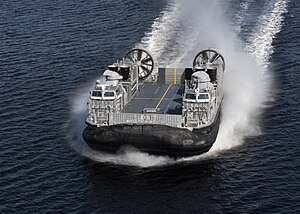| Ship-to-Shore Connector | |
|---|---|
 Ship-to-Shore Connector LCAC 101 in September 2020 | |
| Type | Air-cushioned landing craft |
| Place of origin | United States |
| Service history | |
| In service | In development |
| Production history | |
| Unit cost | US$47.5m (FY15)[1] US$55.5m[1] (inc R&D) (FY15) |
| No. built | 73 planned,[1] 9 under contract.[2] |
| Specifications | |
| Payload capacity | 74 tons[3] or 145 Marines[4] or 108 casualty personnel[4] |
| Maximum speed | Over 35 knots[5] |
The Ship-to-Shore Connector (SSC), also known as the LCAC 100 class,[6] is a system proposed by the United States Navy as a replacement for the Landing Craft Air Cushion (LCAC).[7] It will offer an increased capacity to cope with the growing weight of equipment used by the United States Army and Marine Corps.[5] As of 2015[update], the program is forecast to cost a total of US$4.054B for 73 hovercraft.[1]
- ^ a b c d "GAO-15-342SP DEFENSE ACQUISITIONS Assessments of Selected Weapon Programs" (PDF). US Government Accountability Office. March 2015. p. 121. Retrieved 16 July 2015.
- ^ Osborn, Kris (20 January 2014). "Navy Buys New Landing Craft Air Cushion for Amphibs". Military Advantage. Monster. Retrieved 20 January 2014.
- ^ "Navy To Seek Bids in June for LCAC Replacement". 7 May 2010. Retrieved 15 September 2010.
- ^ a b Textron Starts Work on New Navy Hovercraft - News.USNI.org, 18 November 2014
- ^ a b "SSC Requirements" (PDF). 4 May 2010. Archived from the original (PDF) on 22 July 2011. Retrieved 15 September 2010.
- ^ Landing Craft Air Cushion
- ^ "Textron Marine & Land Systems, L-3 Communications add Alcoa Defense to SSC Team - MarketWatch". Retrieved 15 September 2010.